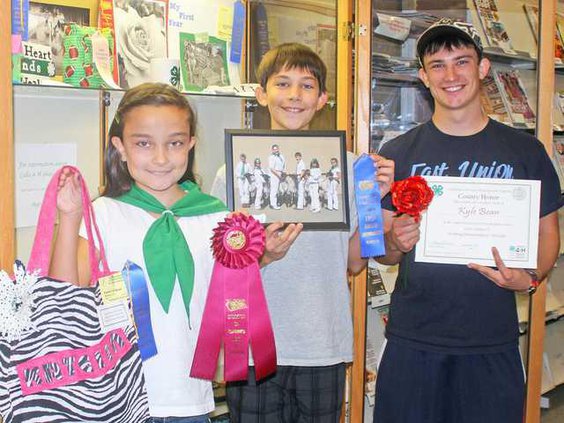Most people have the misconception that 4-H is all about livestock and showing animals at the annual San Joaquin County Fair.
The truth, however, is that this club which goes back more than a century ago is really about young boys and girls raising animals and taking them to county and state fairs – and much, much more.
Kristy Bean and her family know that by heart. There are three generations in her family that have been involved in one of the first youth-development organizations in the United States, starting with her own parents, Lorene and Scott Smith.
While taking animals to the fair and raising livestock “is a big part” of the club’s mission, “4-H offers so much more,” said Bean who, with her children Brandon and Katelin, put together the 4-H display in the Manteca Public Library.
Bean said the exhibit in the library’s display case provides “an overview of 4-H, to show the public what 4-H has to offer. We tried to show off various projects that the kids participate in.”
The display will run through the end of October. The Beans set it up the first week of October in observance of 4-H Week, which is the first week of this month.
While the exhibit was put together by the Bean family who belong to the Calla 4-H, shown in the collection are the works of other members of the club. It is not a comprehensive representation of what 4-H is all about; however, it covers a wide range of the things that 4-H groups do.
Here’s how Kristy Bean describes the groupings in the display as they relate to 4-H activities and projects:
“The top row in the case is showing off the fine arts projects some of our kids entered in the fair or made at project meetings. Shown are photography, scrap booking and arts and crafts.
“The second row is showing a 4-H hat and tie, and the 4-H Record Book that the kids keep during the year and turn in at the end of the 4-H year. Also on this row are pictures of our sewing group showing them at the Fashion Revue and the bag my daughter (Katelin) made in her sewing project and entered in the fair;
“The third row is showing some of our large animal projects such as: dog care, horses and sheep. Not shown is the swine (pig), goats, rabbits groups;
“The bottom row is showing a variety of projects we offer our youth such as skiing/snowboarding, music appreciation, archery/shooting sports and welding. Also shown is 4-H Camp which the kids really enjoy and have lots of fun doing together for a week during the summer.”
There are no representations in the display of the wine, goats and rabbits 4-H groups because Bean, who is one of the 4-H leaders, is not involved in them.
Although this year’s county fair was moved from June to September which affected some youths in FFA and 4-H who are regular participants in the livestock and related shows, “We did have several kids participate in the fair and win various awards,” Bean said.
Among them was her son, Brandon, whose sheep won a blue ribbon, or first place. A long-stemmed metal rose which is part of the library display also won a “medalist prize” at the county fair in the Welding (intermediate) category for the oldest of the Bean siblings, Kyle, who currently attends East Union High. Daughter Katelin’s original award-winning purse project also won big in a competition which saw her creation win the top prize in San Joaquin County and then went on to the state competitions.
The 4-H organization is now grown into the “nation’s largest youth development organization,” according to the group’s official web site, www.4-H.org.
It further explains, “The 4-H idea is simple: help young people and their families gain the skills they need to be proactive forces in their communities and develop ideas for a more innovative economy. That idea was the catalyst to begin the 4-H movement, and those values continue today. …As one of the first youth development organizations in America, 4-H opened the door for young people to learn leadership skills and explore ways to give back. 4-H revolutionized how youth connected to practical, hands-on learning experiences while outside of the classroom.”
4-H Club aims to develop well-rounded youths





